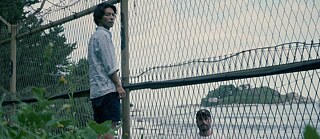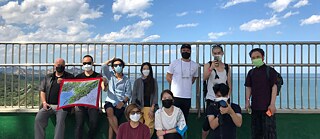German-Korean Theatre Production “Borderline”
“The Iron Curtain wasn’t so iron-clad after all”

On 3 October, thirty years after German reunification, the German-Korean play “Borderline” will premiere at the Residenztheater in Munich. In an interview with “The Latest at Goethe”, playwright Jürgen Berger talks about the differences and similarities between the German and Korean divisions.
By Daniel Welsch
You began doing research for “Borderline” three years ago. How did the idea for this German-Korean co-production come about and how did you come into contact with your Korean colleagues?
Jürgen Berger: Marla Stukenberg, the director of the Goethe-Institut in Korea, played a key role. They conducted the project “Walls – Iphigenia in Exile” there in 2016, a co-production with the Deutsches Theater Berlin, and even then, I had the idea of doing something about the refugee issue and, of course, about the parallels between German reunification and Korea’s waiting for reunification. I wrote an initial sketch and then, one afternoon, had the opportunity to sit down with various directors in Gwangju, where “Walls” was shown. I also spent a long time talking to Kyungsung Lee, who is now directing “Borderline”.
You travelled to South Korea to prepare for the play. What was your research there like?
Jürgen Berger: Most of all, I wanted to talk to North Korean refugees. There are around 30,000 North Korean refugees in South Korea. Most of them flee from North Korea via the border river to China and then arrive in South Korea on very different escape routes – partly via Thailand, partly via Mongolia. There’s a lot on television there about how these refugees fare in South Korea. But I also wanted to talk to refugees who had never given an interview and were still relatively recent arrivals to South Korea. With the help of a pastor who works looking after refugees, we were able to speak to very young refugees. They were between 20 and 25 years old and some of them only arrived in South Korea two or three years ago. Their experiences were still fresh in their minds and they spoke very frankly about their life in North Korea, their escape and their arrival and integration in South Korea. Of course, also about the problems that arise.
What kinds of problems?
Jürgen Berger: For example, just like many refugees from Africa or Syria here in Germany, the refugees try to attract as little attention as possible and want to avoid being recognised as refugees. This happens in Korea mainly through the language, because the North Korean dialect differs from the South Korean and South Koreans notice it straight away. One refugee I interviewed said that she first rid herself of her North Korean dialect and adopted the South Korean dialect. Because recognisability also leads to exclusion.

Jürgen Berger: I couldn’t even say that it changed so much because I’d dealt with this topic a great deal beforehand. But, one thing did become clear to me in the conversation between Robert Lebegern, who is the director of the German-German Museum in Mödlareuth, and the director Kyungsung Lee. Robert Lebegern emphasised in that conversation that the situation here in Germany when reunification happened was completely different from the situation now in Korea.
West Germans were able to travel to East Germany and had candid impressions of the place. And East Germans, if they had good reception, could watch western television. We knew a lot about each other, quite in contrast to Korea, where there is hardly any contact. A major process of alienation is taking place now that many are afraid of. The comparison with the present situation in Korea made me realise that the so-called Iron Curtain wasn’t so iron-clad after all.

Jürgen Berger: It was a very impressive place because thousands of refugees arrived there in 2015, and they made the news back then. During that visit, I found it particularly exciting to see the South Koreans’ reactions to the German-Austrian border. Because there is actually no border at all, while in South Korea you are constantly confronted with obvious borders. The biggest border around South Korea is the sea, and the border with North Korea is the best secured border in the world. You can see it, because the fortifications are even more militarised than those we remember from the German-German border. It’s a stark contrast to the Schengen region where we’re used to there no longer being any visible borders. I then developed a fictionalised story based on the South Koreans’ reaction to this contrast.
In the Residenztheater description, “Borderline” is referred to as docufiction. How do documentary and fictional material interlock here?
Jürgen Berger: I used the interviews with North Korean refugees, retaining what the refugees said, but instead of an interview, I converted it into a narrative without changing anything in terms of content. You don’t have to invent anything when you talk to such contemporary witnesses.
“Borderline” will premiere in Munich on 3 October, the 30th anniversary of Germany’s reunification. Do you perceive Germany as united today?
Jürgen Berger: Not really. We’ve seen time and time again that the way reunification was implemented caused great harm in the new federal states, former East Germany. I believe that this next generation has a greater distance to who were the winners and losers of reunification, but that it’s still deeply rooted in the families, especially in the new federal states, and therefore still plays a major role. The questions of how reunification came about and how political decisions affected individual biographies in East and West will occupy us for quite a while.